(embiggenable)
(embiggenable)
(embiggenable)
FORM - the visible shape or configuration of something … bring together parts or combine to create (something) … make or fashion into a certain shape or form.
CONTENT - The material dealt with in a speech, literary work, etc. as distinct from its form or style ... significance or profundity; meaning ... substantive information or creative material viewed in contrast to its actual or potential manner of presentation
In her essay, Against Interpretation, Susan Sontag opined that "In place of a hermeneutics we need an erotics of art". She advanced the idea that approaching a work of art as that which contains meaning / content which needs to be intrepreted (hermeneutics) intrinsically gets in the way of an unmediated or aesthetically pure experience (erotics) of the form of a work of art. All of which led her to the conclusion / postulation that "... interpretation is the revenge of the intellect upon art".
Sontag believed that a work of art should be experienced and appreciated based on its form. To see the art object for what it is, not for what it might or might not mean. That art should be appreciated for its sensual appeal rather than its appeal to the intellect. Fyi, I couldn't agree more.
For years I struggled with the idea of meaning to be had in a work of art, specifically in a photograph and even more specifically in my pictures. I was troubled, to a certain extent, that, try as I might, I really couldn't find any deep meaning in my pictures.
Why was I troubled? As I came to realize - thank you Susan Sontag (and others) - my troubled state was the result of an an art world canard, a feint which benefited both the academician and critic alike in their "esteemed" roles as interpretors extraordinaire. That is, that art must have meaning to be considered as valuable. Eventually, it dawned on me that in the making of my pictures there was not a single shread of intent to try to put any meaning in my pictures. That what my pictures were "about" was their form.
Consequently, I became very comfortable with the idea that, if a viewer of my pictures wanted to "understand" and/or appreciate them, they would have to come to deal with the luminousness of the thing itself (the print), of that thing being what it is, that it is what it is. If a viewer came looking for meaning, deep or otherwise, in my pictures, he/she would most likely be disappointed.
Nevertheless, I do believe that my pictures do, by means of my intent, have some content / meaning however faint. Content that falls within the idea advanced by William De Kooning:
Content is a glimpse of something, an encounter like a flash. It's very tiny - very tiny, content.
I have a very simple content objective with my pictures - the idea that beauty and coherence can be found in the most innocuous everyday things and events.
Tiny content, indeed.
